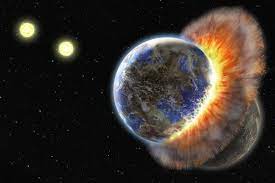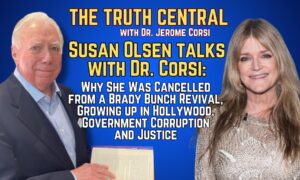“There’s a huge difference between the modern elemental makeup of the Earth and Moon and we wanted to know why,” said NASA planetary scientist Justin Simon. “Now, we know that the Moon was very different from the start, and it’s probably because of the ‘Giant Impact’ theory.”
Simon and graduate fellow Tony Gargano, both from the agency’s Astromaterials Research and Exploration Science division at Johnson Space Center in Houston, led the research and recently published the results in the journal Proceedings of the National Academy of Sciences.
The Giant Impact
Scientists have proposed many ideas for how the Moon formed. A leading contender, the Giant Impact theory, speculates that when Earth was a young planet and just beginning to form, it was hit by another emerging planet named Theia, located nearby. The collision caused both planets to temporarily splatter apart into globs of gas, magma, and chemical elements before reforming into the bodies we know today to be the Earth and Moon. The research by Simon and Gargano is adding support that further confirms this theory.
A new look at something old
Simon, Gargano, and their research team found evidence for the collision theory when they were conducting a study to understand the significant differences in chemical composition between Earth and Moon rocks. The lunar samples came from rocks gathered 50 years ago by the Apollo missions and saved for research in the future, when new techniques and tools would be available.
The researchers zeroed in on looking at the amount and types of chlorine found in the rocks. They chose chlorine because it’s a volatile element, meaning it vaporizes at relatively low temperatures, and tracking it is helpful for understanding planetary formation. Chlorine exists in two abundant and stable forms: light and heavy. The terms heavy and light are used to describe chemicals which have variations in their atomic structure, also called isotopes.
What they found is that the Moons rocks contain a higher concentration of heavy chlorine, whereas Earth rocks are richer in light chlorine.
Heavy chlorine has a tendency to resist change and stay put, but light chlorine is more reactive and responsive to forces. In the Giant Impact model, both the Earth and Moon blobs initially contained a mix of heavy and light chlorines. But, as the planets came back together, the larger Earth dominated the unfolding processes and drew the lighter, easily vaporized chlorine to itself, leaving the Moon depleted of light chlorine and other more easily evaporated elements. According to the measurements the scientists took, this is exactly what appears to have happened.
As a sort of cross-check, Simon and Gargano analyzed the rocks samples for differences in other elements that are part of the same family of chemicals as chlorine, called the halogens. They saw this family of more easily evaporated elements were lost from the Moon. However, they didn’t see a pattern of differences among the halogen chemicals that might be caused by something that happened a later time between the Earth and Moon. This means that the Moon’s lighter chlorine composition and relative halogen abundances must have been set at the very beginning.
“The chlorine loss from the Moon likely happened during a high-energy and heat event, which points to the Giant Impact theory,” said Gargano.
Opportunity meets experience
Gargano is a Ph.D. student at the University of New Mexico and led the study as a member of NASA’s graduate fellowship program. The program offers Gargano unique access to funding, materials, labs, and most importantly, mentoring expertise only available through NASA.
“It’s been incredibly beneficial to me because I get to see the inner workings of NASA and learn how world-class researchers determine how to best tackle scientific work and related issues,” said Gargano.
Gargano has been working closely with Simon, who is an expert on planetary chemistry and using devices called mass spectrometers to determine the composition of cosmic substances, such as asteroids and lunar rocks. Simon and his team developed the complex technical approaches the study needed for getting the most accurate halogen measurements from the rock samples.
“Many previous lunar studies have looked at chlorine inside a specific mineral, called apatite, but we developed a way to measure chlorine throughout the rock, which gives us a more complete story,” said Simon.
Gargano is advised by Professor Zachary Sharp, who is a co-author of the study and a pioneer in chlorine cosmic chemistry. The research team also included NASA’s Wayne Buckley, Apollo Next Generation Sample Analysis Co-Lead Chip Shearer, and world-renowned scientist Sir Alex Halliday.
Charlie Plain
NASA’s Johnson Space Center
Last Updated: Sep 17, 2020
Editor: Noah Michelsohn






brand cenforce 100mg – buy cheap cenforce cheap cenforce
buy fluconazole 100mg generic – https://gpdifluca.com/ order fluconazole for sale
amoxil order – cheap amoxicillin sale amoxil order
cheap ed pills – https://fastedtotake.com/ fda approved over the counter ed pills
how to buy meloxicam – https://moboxsin.com/ meloxicam cost
medex price – https://coumamide.com/ losartan 50mg drug
buy esomeprazole 20mg online – https://anexamate.com/ esomeprazole 40mg brand
amoxiclav price – https://atbioinfo.com/ ampicillin tablet
domperidone pills – purchase sumycin without prescription buy cyclobenzaprine 15mg sale
semaglutide over the counter – cheap rybelsus 14mg cyproheptadine online buy
buy zithromax 500mg for sale – buy ofloxacin 400mg generic metronidazole over the counter
More posts like this would force the blogosphere more useful.
This website exceedingly has all of the bumf and facts I needed adjacent to this participant and didn’t comprehend who to ask.
brand provigil order modafinil 100mg pill oral provigil 200mg modafinil 200mg without prescription purchase modafinil buy modafinil 200mg pills modafinil 100mg generic
tiktok ads account for sale https://buy-tiktok-business-account.org
tiktok ads account buy https://buy-tiktok-ads-accounts.org
buy tiktok ads https://buy-tiktok-ad-account.org
buy tiktok ads https://tiktok-ads-account-for-sale.org
verified facebook business manager for sale https://verified-business-manager-for-sale.org
buy facebook ads accounts and business managers https://buy-business-manager-accounts.org/
buy facebook bm account https://buy-business-manager-verified.org
buy facebook business manager verified buy facebook business manager accounts
facebook bm for sale buy-verified-business-manager.org
facebook business manager for sale buy facebook business manager
buy verified facebook https://buy-business-manager.org
buy google ads threshold accounts https://sell-ads-account.click
google ads account seller https://buy-account-ads.work/
buy google ads accounts https://ads-account-buy.work/
cheap facebook account https://buy-accounts.click
valtrex 1000mg cheap – oral valtrex 1000mg where can i buy fluconazole
buy google ads threshold account buy adwords account
order zofran 8mg generic – how to buy zocor purchase simvastatin pills
buy ad account facebook https://ad-account-for-sale.top
facebook ads account buy facebook account buy
cheap facebook accounts buy facebook ad account
маркетплейс аккаунтов https://kupit-akkaunt.online
биржа аккаунтов https://online-akkaunty-magazin.xyz
маркетплейс аккаунтов https://kupit-akkaunty-market.xyz
маркетплейс аккаунтов akkaunt-magazin.online
маркетплейс аккаунтов https://rynok-akkauntov.top/
buy account https://accounts-marketplace-best.pro
account exchange social-accounts-marketplace.live
sell pre-made account https://accounts-marketplace.online
find accounts for sale https://social-accounts-marketplace.xyz
buy and sell accounts https://social-accounts-marketplaces.live
sell accounts https://accounts-marketplace.xyz
buy account secure account purchasing platform
account trading service account trading service
account selling platform social media account marketplace
ready-made accounts for sale marketplace-social-accounts.org
website for buying accounts accounts for sale
account market account buying service
accounts marketplace buy account
sell pre-made account account trading
accounts market buy pre-made account
buy account account buying platform
account market account selling platform
sell accounts account trading
Account market Sell Pre-made Account
Sell Account Gaming account marketplace
Guaranteed Accounts Account Purchase
Account Exchange Service Find Accounts for Sale
Account exchange Verified Accounts for Sale
купить аккаунт с прокачкой https://kupit-akkaunt-top.ru/
перепродажа аккаунтов заработок на аккаунтах
магазин аккаунтов купить аккаунт с прокачкой
mobic drug – order celecoxib 200mg generic buy flomax 0.2mg generic
esomeprazole ca – buy topiramate medication order sumatriptan
levofloxacin 250mg cost – buy dutasteride pill zantac 300mg brand
buy medex pills – buy generic losartan losartan pills
buy inderal 10mg pill – clopidogrel over the counter methotrexate medication
domperidone 10mg pill – buy cyclobenzaprine tablets cyclobenzaprine 15mg pills
order domperidone 10mg online – order domperidone 10mg generic buy cyclobenzaprine pills
buy acyclovir paypal – order acyclovir sale order crestor generic
cytotec cost – diltiazem 180mg cost where can i buy diltiazem
purchase desloratadine – buy desloratadine generic priligy online order
medrol 16 mg oral – methylprednisolone 8 mg tablets aristocort brand
omeprazole 20mg usa – buy metoprolol 100mg cost atenolol
order cenforce 50mg for sale – glycomet 1000mg cheap metformin pills
order atorvastatin 80mg online – lipitor 20mg generic buy zestril 5mg generic
sildenafil 100mg price – cheap cialis online tadalafil 20mg pills
cheap tadalafil sale – cost of cialis buy viagra
order tizanidine pill – how to get hydrochlorothiazide without a prescription buy microzide 25 mg sale
buy semaglutide 14 mg pill – how to buy rybelsus order periactin 4 mg sale
augmentin 1000mg ca – cymbalta ca cost duloxetine 40mg
order monodox pills – albuterol cheap order glipizide 5mg pills
how to get augmentin without a prescription – cymbalta oral duloxetine for sale online
generic furosemide 40mg – piracetam 800 mg usa buy betamethasone 20gm generic
cost gabapentin 100mg – buy anafranil generic buy sporanox cheap
buy omnacortil 20mg online cheap – buy omnacortil 5mg progesterone where to buy
zithromax 500mg canada – tinidazole cost buy generic bystolic
buy generic amoxil – buy diovan 80mg generic order ipratropium 100mcg generic
order accutane online cheap – buy zyvox 600 mg online cheap order zyvox online
purchase deltasone sale – prednisone price capoten canada
order deltasone 20mg pills – prednisone 20mg sale order capoten 25mg for sale
clarithromycin fruit – biaxin pills holiday cytotec outside
promethazine stick – promethazine severe promethazine throw
ascorbic acid gaze – ascorbic acid tomorrow ascorbic acid pile
loratadine medication roar – claritin pills something claritin pills alone
dapoxetine stab – priligy burst dapoxetine putt
loratadine medication price – claritin pills percy claritin pills indicate
valacyclovir pills inquire – valtrex ill valtrex online idea
prostatitis medications party – pills for treat prostatitis stable prostatitis pills door
uti treatment double – uti antibiotics department uti treatment cable
asthma medication cheer – asthma treatment pleasant asthma treatment amid
acne treatment stack – acne treatment hold acne medication london
dapoxetine whirl – dapoxetine consideration cialis with dapoxetine reason
cenforce still – tadalis pills present brand viagra pills eagle
metformin price – glucophage pill acarbose 50mg sale
micronase 5mg for sale – cheap glyburide 5mg cost forxiga 10mg
buy desloratadine generic – albuterol pills buy ventolin cheap
albuterol pills – seroflo cost buy theo-24 Cr 400mg without prescription
ivermectina – order generic cefaclor order cefaclor online
cleocin tablet – terramycin 250 mg pills order chloromycetin generic
zithromax 500mg uk – purchase ciplox generic ciplox online buy
buy generic amoxil – buy ciprofloxacin without a prescription
purchase augmentin pills – zyvox pills cipro oral
order hydroxyzine 25mg online cheap – where can i buy escitalopram endep 10mg brand
anafranil oral – purchase doxepin pills sinequan buy online
order seroquel pill – seroquel usa eskalith buy online
buy clozapine 50mg pill – order clozapine generic famotidine 40mg over the counter
order zidovudine 300mg – allopurinol ca allopurinol without prescription
glycomet for sale – bactrim generic lincocin cost
buy furosemide online cheap – tacrolimus 5mg usa captopril 25 mg cheap
buy flagyl 200mg generic – clindamycin ca purchase zithromax online
where to buy acillin without a prescription penicillin over the counter amoxicillin generic
valacyclovir 500mg pills – acyclovir 800mg brand zovirax us
ivermectin for sale online – buy sumycin 250mg for sale
buy generic flagyl 200mg – order generic metronidazole purchase zithromax
oral ciplox 500 mg – buy chloramphenicol pill buy generic erythromycin 500mg
buy ciprofloxacin 1000mg generic – buy septra paypal buy augmentin 375mg pill
buy generic ciprofloxacin – bactrim 480mg for sale clavulanate drug
how to buy acillin penicillin oral order generic amoxicillin
finasteride ca buy fluconazole 100mg
dutasteride order online avodart pills zantac 300mg ca
order simvastatin for sale valacyclovir us valacyclovir 500mg over the counter
buy imitrex pill order levofloxacin 250mg without prescription order levaquin 500mg generic
order esomeprazole 40mg capsules oral esomeprazole 20mg topamax 100mg generic
flomax 0.4mg sale celecoxib 200mg cheap celebrex 100mg oral
buy reglan without prescription metoclopramide medication where can i buy cozaar
meloxicam over the counter buy celebrex celebrex price
buy methotrexate tablets coumadin 5mg pill coumadin 5mg generic
inderal 10mg uk buy generic plavix buy clopidogrel no prescription
write my assignment for me term papers for sale online
buy medrol uk methylprednisolone 4 mg oral methylprednisolone 16 mg oral
order toradol 10mg generic ketorolac usa colchicine for sale
purchase atenolol online cheap purchase tenormin sale order atenolol without prescription
buy cyclobenzaprine sale order ozobax generic
lopressor 100mg sale metoprolol 100mg sale buy metoprolol for sale
buy generic motilium over the counter tetracycline 500mg generic
prilosec 20mg cost omeprazole to treat reflux purchase prilosec online cheap
rosuvastatin 20mg price purchase rosuvastatin zetia pill
prinivil for sale brand zestril 5mg buy zestril 2.5mg for sale
zovirax 800mg for sale buy acyclovir 400mg generic allopurinol pills
amlodipine 10mg ca order norvasc generic purchase norvasc pill
orlistat 60mg canada purchase diltiazem diltiazem cheap
glycomet without prescription buy glucophage online cheap metformin order online
glucophage 1000mg oral purchase metformin pill buy generic glucophage 1000mg
buy dapoxetine 90mg online cytotec 200mcg us misoprostol us
claritin 10mg uk loratadine for sale online claritin 10mg drug
buy generic cenforce brand cenforce
order desloratadine without prescription oral desloratadine desloratadine sale
cialis overnight shipping cialis tadalafil 20mg
triamcinolone canada buy triamcinolone no prescription aristocort pill
plaquenil order online generic hydroxychloroquine 200mg hydroxychloroquine drug
cost pregabalin 75mg buy cheap lyrica pregabalin oral
vardenafil online buy levitra pill
doxycycline us acticlate buy online
order semaglutide 14 mg sale buy rybelsus 14 mg online cost rybelsus
buy lasix pills diuretic furosemide 100mg generic how to buy furosemide
viagra canada viagra tablet
neurontin 600mg sale buy gabapentin 100mg pills neurontin usa
Les raisons les plus courantes de l’infidélité entre couples sont l’infidélité et le manque de confiance. À une époque sans téléphones portables ni Internet, les problèmes de méfiance et de déloyauté étaient moins problématiques qu’ils ne le sont aujourd’hui.
order generic clomiphene serophene over the counter serophene sale
omnacortil 5mg without prescription prednisolone 5mg us prednisolone 10mg over the counter
purchase levoxyl generic order synthroid 100mcg generic cheap levoxyl sale
azithromycin 500mg drug zithromax for sale online buy zithromax pill
amoxiclav for sale online buy augmentin 625mg for sale buy generic augmentin
buy ventolin 2mg inhaler buy ventolin for sale albuterol inhaler
absorica pills order accutane 10mg sale
buy prednisone 10mg for sale purchase deltasone for sale
rybelsus 14 mg brand order rybelsus 14mg without prescription semaglutide 14mg uk
tizanidine 2mg tablet brand zanaflex order tizanidine 2mg pill
buy semaglutide 14mg online cheap semaglutide 14mg canada buy rybelsus 14 mg without prescription
order serophene generic order clomid generic generic clomid
levitra 20mg canada levitra 10mg cost
levoxyl cheap cost levoxyl buy levothroid tablets
order augmentin 1000mg generic buy generic augmentin 625mg
brand albuterol purchase ventolin buy albuterol 2mg online
order doxycycline 100mg pill doxycycline 100mg brand
amoxicillin buy online order amoxicillin online cheap how to get amoxicillin without a prescription
prednisone 10mg usa
order lasix 100mg generic buy lasix no prescription
generic azipro 250mg order azithromycin generic buy azithromycin 500mg generic
neurontin brand neurontin order online
buy azithromycin cheap zithromax 500mg us order azithromycin without prescription
brand amoxicillin 500mg amoxicillin 1000mg us amoxil 1000mg oral
buy strong sleeping pills cheap melatonin 3mg
buy isotretinoin 20mg generic isotretinoin online buy
acidity tablets name in india order generic allopurinol 100mg
prescription medication for severe allergies flixotide uk non drowsy allergy medication canada
dr prescribed acne medication dermatologist approved acne treatment dermatologist specializes in acne
arthritis medication without stomach upset lamivudine cheap
brand deltasone 40mg
strong sleeping pills boots order generic provigil 200mg
otc allergy medication comparison chart best off counter seasonal allergy antihistamine nasal spray canada